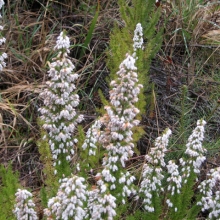
Spanish heath (Erica lusitanica)
Other common names
Portuguese heath, Spanish heather
Description
A woody, upright, perennial, evergreen shrub, growing up to 10 feet tall. Leaves are light-green, needle-like, 3 to 7 mm long, and arranged around the stem in groups (whorls) of three to four. Blooms are a showy mass of small, white to pink, bell-shaped (tubular) flowers, with three bracts, four sepals and a corolla. Plants begin flowering in December and continue until April. Fruit are smooth capsules about 3 mm in diameter containing many very fine, pepper-sized seeds. Large plants produce millions of easily transported seeds. These seeds may be wind-, water-, animal- or human-transported. Spread could be rapid.
Impacts
Spanish heath is a weedy, ornamental species of Erica known from only a few sites in Curry and Coos counties in Oregon. First established in Oregon in the 1970s at a rare plant nursery near Langlois, it slowly spread for decades until recently, with its population now increasing exponentially. Growing up to 10 feet tall, this species produces up to 9 million seeds per plant and is capable of forming dense stands in forestlands, wild areas, pastureland and on right-of-ways. It will be a troublesome weed to control, should it be allowed to spread in western Oregon. Spanish heath has infested large areas in Northern California (Humboldt and Del Norte Counties) and is demonstrating a capacity to infest similar habitat in Oregon and Washington. It is well adapted to moist, acidic soils and could infest a wide range of shrub and forest habitats. In California, it is commonly found growing in close association with Gorse, Scotch and French broom, and blackberry, especially along utility right-of-ways, riparian areas, and roadsides. It provides limited forage for grazing animals and few insects, so it grows rapidly with limited herbivore pressure. Other impacts can include reduction in native plant diversity, invasion of riparian areas, competition with conifer and broadleaf tree species, and overall degradation of the land base. Currently, Spanish heath infestations in Oregon are rare and impacts are minimal. Because of the experience of land managers in Australia and New Zealand under similar conditions, significant impacts to Oregon’s wildlands, forestlands, pastures and right-of-ways could occur. Competition from it could significantly impact forest regeneration and productivity, especially in Coos and Curry Counties. Pasture productivity would suffer as edible forage becomes out-competed by this less desirable shrub. Right-of-way maintenance costs would increase in infested areas. Mowing has no long-term impact on the species, and the high seed output would quickly establish dense stands blocking access roads for power lines, reducing line-of-sight on public highways, and increasing the opportunity for roadside fires in areas where herbicide use is restricted. In the cranberry-growing region of southwestern Oregon, it favors the open ground, dikes and access roads near cranberry bogs. Increased herbicide use would be required to maintain existing open ground and infrastructure. In all susceptible areas, control costs to contain or eradicate populations would be significant.



